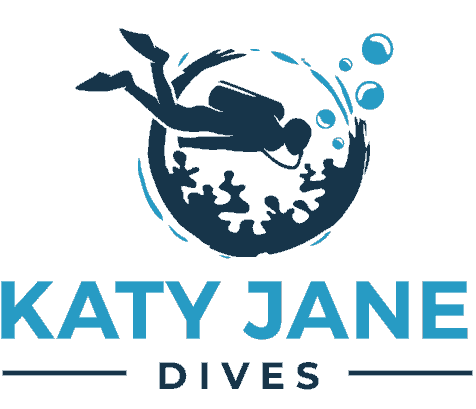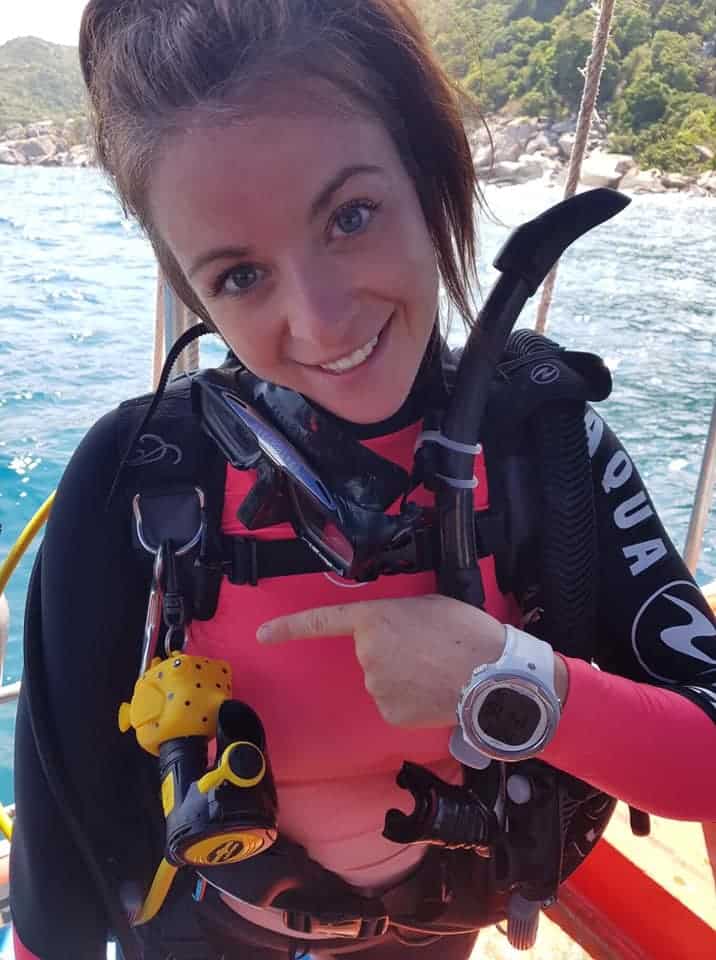The Bahamas, with the world’s third-largest barrier reef, attracts divers with its vast array of dive experiences: drift dives, wall dives, reef dives, shark dives, and wreck dives.
Key sites include the Andros Wall, known for its spectacular drop-offs and unique underwater formations. Protected areas, such as the Exuma Cays Land and Sea Park established in 1958, safeguard the region’s marine biodiversity, offering pristine conditions for diving.
Discover which of these stunning locales rank as the ultimate diving destinations in the Bahamas by reading further.
Table of Contents
Best Dive Sites in the Bahamas
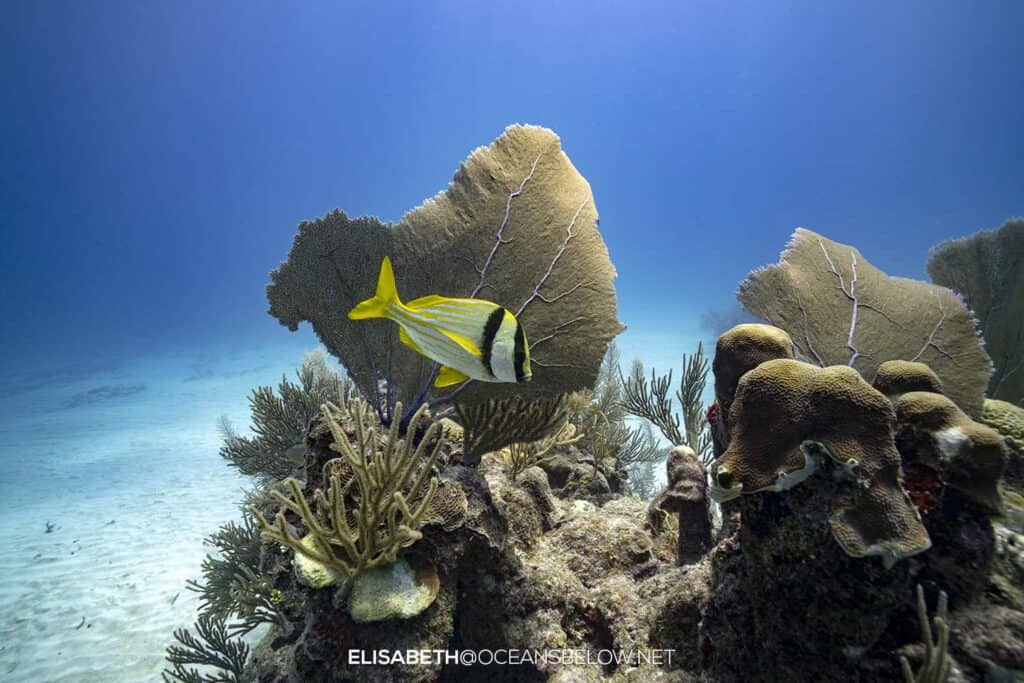
Whether you’re excited to dive alongside tiger sharks and reef sharks or you’re looking to enjoy some of the unique wall diving, there’s plenty of choice.
Ranging across 600 miles from North to South, there is a lot to see. Let’s take a look at the best diving sites in the Bahamas Islands:
Andros Island
- Location: Western part of the country
- Perfect For: Requires at least an Advanced Open Water Diver certification or equivalent
- Likely to See: Colorful coral reefs with diverse reef fish, sharks (reef and nurse sharks), dolphins, rays, sea turtles, and various pelagic species. The island's blue holes and underwater cave systems also offer unique opportunities for exploration
- Temperature:75°F to 85°F (24°C to 29°C)
- Visibility: 100 feet (30 meters) or more
- Depth: 20 feet (6 meters) to 100 feet (30 meters)
Andros Island secures the top spot as the premier diving destination in the Bahamas, celebrated for its awe-inspiring blue holes.
These natural underwater phenomena draw divers with their exceptional clarity and depths, offering visibility often exceeding 200 feet and descending into the hundreds of feet, setting a remarkable stage for underwater exploration.
The allure of Andros’ blue holes lies not just in their depth and clarity but in their unique ecosystem, housing diverse marine life and intricate cave systems. This distinct feature makes them a coveted site for divers seeking both adventure and the thrill of discovery.
Adjacent to this, the Andros Wall presents an unparalleled wall diving experience. It dramatically drops over 6,000 feet close to the shore, adorned with vibrant coral formations and teeming with aquatic life, offering a mesmerizing glimpse into the ocean’s depths.
This combination of profound depth, clear waters, and rich biodiversity cements Andros Island’s reputation as a must-visit destination for divers around the globe. The island’s unique underwater topography, including the blue holes and the Andros Wall, highlights its unparalleled appeal in the diving community.
Shark Buoy, New Providence
- Location: Northeast coast of New Providence Island
- Perfect For: Beginner upwards
- Likely to See: Diverse reef and wall diving with sharks, turtles, eagle rays, and schooling fish, wreck diving with vessels of all sizes, penetration routes, and outstanding conditions
- Temperature: 22°C to 31°C
- Visibility: 20 to 40 meters
- Depth: 10 to 40 meters
Shark Buoy, located off New Providence, is a thrilling dive site celebrated for its dynamic shark encounters. Divers flock here to experience close-up views of Caribbean Reef Sharks in their natural habitat, making it a premier destination for shark diving enthusiasts.
The site is characterised by clear waters, offering visibility up to 100 feet, which ensures divers can fully appreciate the marine life and interactions with sharks. Depths at Shark Buoy average around 18 metres or 60 feet, making it accessible for intermediate divers while providing an exhilarating experience.
Unique to Shark Buoy is the buoy itself, around which sharks congregate, creating a mesmerizing spectacle. This dive offers a unique opportunity to observe shark behavior up close, contributing to its reputation as a must-visit location within the Bahamas’ diving community.
Look out for dive schools that offer the PADI AWARE Shark Conservation speciality to enhance your experience.
Sugar Wreck, Grand Bahama
- Location: Off the West End of Grand Bahama Island
- Perfect For: Beginner upwards
- Likely to See: Congregations of snappers, grunts, wrasse, gobies, angelfish and parrotfish are everywhere on the wreck
- Temperature: 77 F (25 C)
- Visibility: 42 feet (13 meters)
- Depth: 20 feet (6 meters)
Sugar Wreck, located off Grand Bahama, is a dive site steeped in history and marine biodiversity. This shallow wreck, resting in just 20 feet of water, was a 19th-century sailing ship that carried molasses, lending the site its sweet name.
The wreck’s accessibility makes it an ideal spot for both novice and experienced divers. Abundant marine life, including schools of colorful fish, sea turtles, and nurse sharks, thrives among the wreckage, creating a vibrant underwater ecosystem.
Unique to Sugar Wreck is its combination of historical intrigue and ecological richness. Divers can explore the well-preserved structure and its coral-encrusted surfaces, making it a photographer’s paradise and a haven for underwater exploration.
Current Cut, Eleuthera
- Location: East of Nassau, the capital of the Bahamas
- Perfect For: Beginner to advanced
- Likely to See: vibrant coral reefs with diverse reef fish, sea turtles, sharks (reef sharks and nurse sharks), rays, dolphins, wrecks for diving, and opportunities for bonefishing. Enjoy clear waters with excellent visibility for snorkeling and diving
- Temperature: 75°F to 85°F (24°C to 29°C)
- Visibility: 100 feet (30 meters)
- Depth: 20 feet (6 meters) to 100 feet (30 meters)
Current Cut, situated off Eleuthera, is renowned for its exhilarating drift dive experience. This narrow channel, with currents reaching up to 10 knots, offers a unique underwater ride that is unmatched in the Bahamas.
The dive site is a magnet for advanced divers seeking the thrill of navigating through swift water movements. Rich in marine life, divers can encounter an array of species such as sharks, rays, and large schools of fish, propelled by the currents.
Current Cut’s distinctiveness lies in its dynamic underwater landscape and the adventure it promises. Divers are treated to a fast-paced journey past coral formations and through a vibrant marine ecosystem, making it a memorable dive.
Tiger Beach, Grand Bahama
- Location: Roughly 20 miles off the coast of West End
- Perfect For: Advanced and experienced open water divers
- Likely to See: Incredible shark diving experiences, particularly with tiger sharks, lemon sharks, and nurse sharks
- Temperature: 88°F (31°C)
- Visibility: 400ft (120m)
- Depth: 65 feet (20 meters)
Tiger Beach, off the coast of Grand Bahama, is celebrated for its close-up shark encounters, particularly with tiger sharks. This shallow sand flat, with depths averaging around 20 feet, provides a safe and controlled environment for divers of all levels to observe these majestic predators.
Renowned for its clear waters and high visibility, Tiger Beach allows for unparalleled photographic opportunities and intimate wildlife experiences. Divers can also encounter lemon, nurse, and Caribbean reef sharks, adding to the site’s allure.
What sets Tiger Beach apart is its status as one of the world’s premier locations for shark diving. The opportunity to dive with tiger sharks in their natural habitat, combined with the site’s accessibility and safety measures, makes it a bucket-list destination for marine enthusiasts.
Tiger Beach is a true reflection of the protection of the Bahamas and its positive effects on the marine ecosystem.
The Washing Machine, Exumas
- Location: North of the Exuma Cays
- Perfect For: Advanced to experienced open water divers
- Likely to See: Colourful tropical fish, schools of Batfish, small underwater jungles of soft and hard corals, sea turtles and timid nurse sharks
- Temperature: 81-85°F/27-29°C
- Visibility: approximately 30m (100ft)
- Depth: 12m (40ft) initially and then lift you right back up to 5m (15ft) onto a sea ledge
The Washing Machine, located in the Exumas, is celebrated for its unique natural phenomenon that offers a one-of-a-kind dive experience. Divers are propelled through a narrow channel by powerful, swirling currents, reminiscent of being in a giant underwater washing machine.
This site is a favorite among thrill-seeking divers, attracted by the exhilarating rush and the challenge it presents. The dive concludes in a calm lagoon teeming with vibrant coral and marine life, providing a stark contrast to the dynamic journey.
What sets The Washing Machine apart is not just the adrenaline-inducing currents but also the opportunity to witness a diverse aquatic ecosystem in the serene aftermath. It’s an adventure dive that combines natural spectacle with rich biodiversity, making it a must-visit location in the Exumas.
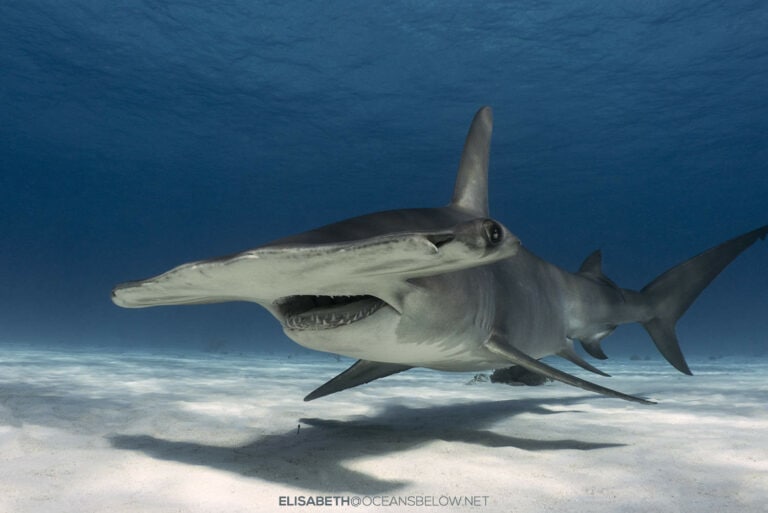
See more of Elisabeths images at her website Oceans Below
Deans Blue Hole, Long Island
- Location: Next to Clarence town, in Long Island, Bahamas
- Perfect For: Open water diver the least, due to the depth, specialized training and certifications in deep diving and technical diving
- Likely to See: Native species like parrot fish, butterfly fish, and blue damsels can be seen swimming amongst the reefs, also dolphins, turtles and sharks
- Temperature: 24° C/75° F (December to March) and 31° C/88° F in the summer (June to August)
- Visibility: 115 feet (35 meters)
- Depth: 663 feet (202 meters)
Dean’s Blue Hole on Long Island stands as the world’s second deepest blue hole, plunging to a depth of over 660 feet (202 meters). This natural wonder is encircled by a ring of sandy beach and limestone rock formations, creating a stunning contrast against the deep blue of the water.
Renowned for its crystal-clear visibility and the diversity of marine life in the shallows, Dean’s Blue Hole attracts snorkelers and freedivers as well as scuba divers. The vertical cave beneath the surface houses a variety of fish and other sea creatures, nestled among its walls.
What makes Dean’s Blue Hole unique is not only its impressive depth but also its accessibility for a range of water sports enthusiasts. This site offers a serene yet mysterious diving experience, inviting divers to explore its depths and the secrets held within.
Sapona, Bimini
- Location: Off the coast of Bimini in the Bahamas
- Perfect For: Bimini typically requires at least an Open Water Diver certification
- Likely to See: Colorful reef fish, schools of baitfish, and possibly barracudas.
- Temperature: 75°F to 85°F (24°C to 29°C)
- Visibility: 100 feet (30 meters)
- Depth: 20 feet (6 meters) near the top to approximately 50 feet (15 meters) at the seabed
Sapona, resting off the coast of Bimini, is a historical wreck dive that captivates with its story and marine life. This early 20th-century concrete ship, partially submerged, serves as an artificial reef, attracting a diverse array of aquatic creatures.
The wreck’s shallow depth, approximately 15 feet (4.5 meters) to the top and 20 feet (6 meters) to the sea floor, makes it accessible to snorkelers and divers of all skill levels. Encrusted with coral and home to schools of tropical fish, Sapona is a haven for underwater photographers and marine life enthusiasts.
Sapona’s allure lies in its combination of historical intrigue and ecological richness. Offering an immersive dive experience, it invites exploration of its wreck and the vibrant ecosystem it supports, making it a must-visit site in Bimini.
Bimini Road, Bimini
- Location: Near North Bimini island in the Bahamas
- Perfect For: basic Open Water Diver certification or equivalent
- Likely to See: Unique limestone formations resembling a road, diverse marine life, including reef fish and coral
- Temperature: 75°F to 85°F (24°C to 29°C)
- Visibility: 100 feet (30 meters)
- Depth: 10 feet (3 meters) to 25 feet (8 meters)
Bimini Road, often dubbed the “Atlantis Road,” is a mysterious underwater formation off the coast of Bimini Island. Composed of rectangular and sub-rectangular limestone blocks laid out in a road-like pattern, this site has intrigued archaeologists and divers alike.
The formation lies in relatively shallow water, making it accessible for both snorkelers and scuba divers. The clarity of the water allows for excellent visibility, offering a clear view of the enigmatic arrangement and the marine life that has made it home.
Bimini Road’s unique feature is its controversial and speculative history, with debates surrounding its natural versus man-made origin. This site not only offers a fascinating dive experience but also invites exploration into the mysteries of the past, captivating those who visit.
Conception Island Wall, Long Island
- Location: Central-eastern part of Bahamas
- Perfect For: Open Water Diver certification is typically sufficient
- Likely to See: Pristine pink sand beaches, gorgeous sandstone cliffs, healthy mangroves and an extraordinary abundance of wildlife on land and in the sea
- Temperature: 75°F to 85°F (24°C to 29°C)
- Visibility: 100 feet (30 meters)
- Depth: 60 feet (18 meters)
Conception Island Wall, off Long Island, is celebrated for its dramatic drop-offs and pristine marine environment. This secluded dive site, part of a protected national park, plunges into the deep blue, offering wall diving at its finest.
The wall’s biodiversity is exceptional, with vibrant coral gardens, sponges, and a myriad of fish species making their home along the steep descent. Divers might encounter pelagic species as they navigate the clear waters, with visibility often exceeding 100 feet.
Unique to Conception Island Wall is its untouched beauty, owing to the site’s protected status. It presents an underwater spectacle of color and life, drawing divers into a world where nature flourishes undisturbed, making it an unforgettable dive destination.
Conservation of the Bahamas Marine Life
The Bahamas has actively protected its marine ecosystems since the late 1950s, culminating in the establishment of a Shark Sanctuary and over 13 million acres of Marine Protected Areas (MPAs) to date.
This places the Bahamas as the fourth country globally to enact such comprehensive shark protections, a critical step towards its goal of conserving half of its marine environments, showcasing its leadership in marine conservation.
Timeline of Conservation in The Bahamas
- Late 1950s: The Bahamas begins its conservation efforts, laying the groundwork for future marine protection initiatives.
- 1986: The Bahamas National Trust Act establishes the Bahamas National Trust (BNT), a legal entity with the mandate to conserve the natural resources of The Bahamas.
- 1992: The establishment of the Exuma Cays Land and Sea Park, the first marine protected area in the Caribbean, signifies a major step in marine conservation.
- 2000s: Expansion of protected areas continues, focusing on critical habitats like coral reefs, mangroves, and sea grass beds.
- 2011: The Bahamas declares its entire exclusive economic zone (EEZ) as a Shark Sanctuary, becoming the fourth country in the world to offer such comprehensive protection for sharks.
- 2015: A significant increase in the number of Marine Protected Areas (MPAs), aiming to protect over 13 million acres of marine ecosystems.
- 2020: The Bahamas commits to protecting 20% of its nearshore marine environments by 2020, in line with the Caribbean Challenge Initiative.
This timeline illustrates the progressive steps The Bahamas has taken towards marine conservation, demonstrating a long-term commitment to preserving its unique marine biodiversity.
How to Dive the Bahamas
The best way to reach every dive site in Bahamas, is to do it via a Liveaboard trip. The Bahamas is a country made up of hundreds of islands, yet only about 30 of them are inhabited.
However, if you do not fancy the idea of a Liveaboard and are looking for more freedom (and have the cash to do so) then flying to different locations is a possibility. There are 23 domestic airports that keep the islands well-connected.
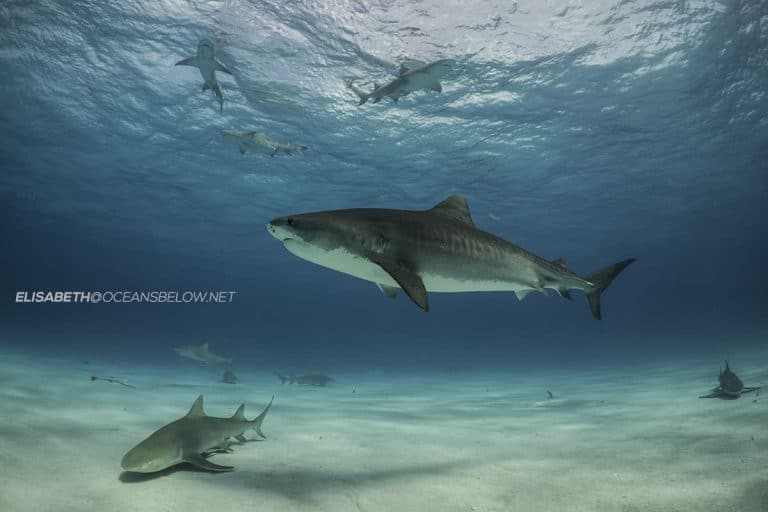
Other Dive Destinations
When is the Best Time to Dive in the Bahamas?
The best time to scuba dive in the Bahamas is between November and May.
November through May offers warm and dry conditions ideal for better diving visibility and more chance to dive with sharks.
June through October is the rainy season in the Bahamas, making it less desirable for scuba divers.
If you’re hoping to enjoy majestic hammerheads while scuba diving then head to Bimini Islands between December and March.
Bahamas Water Temperature
Bahamas water temperature remains hot all year round, offering the perfect dive conditions. The water has a high of 30.1°C and a low of 23.2°C.
Here is a chart showing the Bahamas water temperature by month.
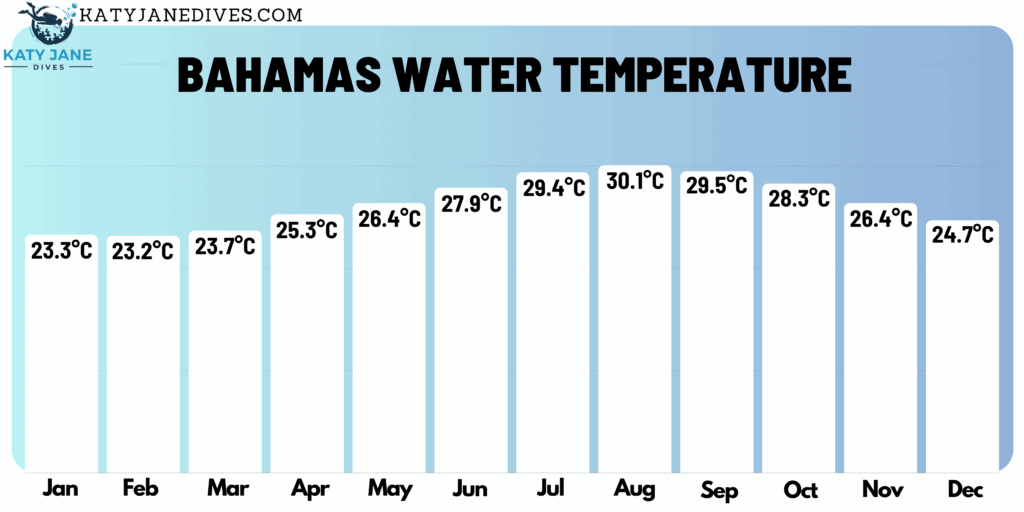
Recommended Diving Certifications for the Bahamas
For scuba diving in the Bahamas, the recommended certifications include Open Water Diver for beginners, allowing exploration of many beautiful shallow sites. Advanced Open Water Diver certification is suggested for more challenging dives, such as deeper wrecks and wall dives, offering access to a broader range of dive sites.
Speciality certifications, such as Wreck Diver or Deep Diver, enhance the diving experience at specific sites like the Andros Wall or deep blue holes. Enriched Air Nitrox certification is also beneficial, extending bottom times at deeper sites.
These certifications ensure divers are prepared to safely enjoy the diverse underwater landscapes the Bahamas has to offer.
What Role does Shark Ecotourism Play in the Bahamas?
Shark ecotourism in the Bahamas plays a pivotal role in marine conservation and the local economy, transforming the perception of sharks from feared predators to valuable marine assets. An individual live reef shark, for example, is valued at $250,000 due to dive tourism, highlighting the economic benefit of preserving these creatures in their natural habitat.
Globally, shark ecotourism generates over $300 million annually, a figure projected to rise to $700 million over the next two decades. The Bahamas, known for its clear warm waters and diverse shark populations, including Oceanic Whitetips, Hammerheads, Tiger sharks, Bull sharks, Nurse sharks, and Silkys, offers unparalleled opportunities for intimate shark encounters.
This thriving sector not only contributes significantly to the Bahamian economy but also fosters a greater understanding and respect for these majestic animals, underscoring the importance of sustainable interaction with our oceans’ apex predators.
Want to learn more about diving with sharks? Read my article on the subject and the effects of ecotourism here.
Conclusion
In conclusion, the Bahamas stands as a premier destination for divers worldwide, offering an unrivaled array of underwater experiences. From the mysterious depths of Andros’ blue holes to the exhilarating encounters with diverse shark species, the islands cater to every level of diving expertise.
The economic and ecological significance of sustainable practices like shark ecotourism further underscores the Bahamas’ commitment to marine conservation. With its clear, warm waters and rich marine biodiversity, the Bahamas promises unforgettable dive adventures and plays a crucial role in the global effort to preserve our oceans for future generations.
